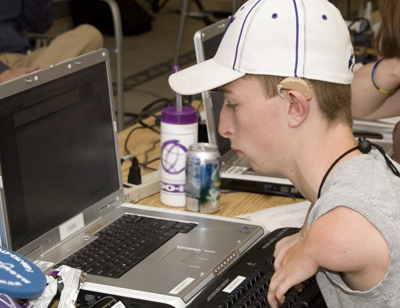Reports from Working Group Discussions (Access to Computing in Higher Education: Capacity Building for BPC Projects 2010)

CBI participants represented a wide range of stakeholders, including postsecondary faculty and staff, and employees of BPC projects serving students around the country. They came together to brainstorm and share ideas about how to better serve students in computing fields in postsecondary education. The following lists present some of the ideas shared in the brainstorming discussions.
Question 1
How can disability support services, computing departments, veterans organizations, and other groups work together effectively to increase the number of people with disabilities in the computing sciences?
- Try to change the campus culture of communication about disability. Advocate for a welcoming and accessible approach with respect to current and potential students with disabilities.
- Assign faculty members as points of contact for students with disabilities. These members can ensure resources are available to students via email, websites, and service units and individuals.
- Create K-12 outreach programs where students, including those with disabilities, can come to a postsecondary campus or hold transition programs at local schools. These offerings should send a positive, welcoming message to incoming freshmen with disabilities, and make them aware of campus resources available to them.
- Invite guest speakers to campus who have disabilities or who are developing technology for people with disabilities.
- Make faculty and staff more aware of different types of disabilities (invisible and visible) via brochures and online resources.
- Provide recruitment links to an online class list when someone in class needs a note taker.
- Make sure the campus offices of student services are well equipped with individuals to proctor extended-time exams.
- Ensure that academic technology services (e.g., computing commons areas and help desks) support assistive technology and facilities.
- Train faculty so that they can effectively work with students who have disabilities and encourage them to share ideas with each other regarding how to best work with a student who has a disability.
- Offer all students suggestions for research topics that benefit people with disabilities, such as the design of robotics to do assistive tasks.
- Create prominent online lists of campus resources that are available to students with disabilities.
- Ensure that a welcoming environment and attitude is present in student service offices.
- Have campus administrators tour the campus to observe how welcoming and accessible their schools are to students with a variety of disabilities.
- Do not let anyone feel like a second class citizen.
- Integrate assistive technology within general-access computing labs.
Question 2
What specifically can your computing department, disability support service office, veterans organization, or other campus service do to improve the recruitment and support of students with disabilities in computing departments and IT careers?
- Work to ensure that students with disabilities are fairly represented in the student body.
- Offer sensitivity training for faculty, student service offices, and campus administrators.
- Be sensitive to issues surrounding the circumstances of disability-related incidents around campus (hirings, firings, action planning).
- Redesign tests to take the emphasis away from time limits.
- Address issues surrounding exam proctoring for students with disabilities and improve communication between disability service offices, faculty, and the student who needs extended time for tests.
- Hold lectures as if a student with a disability was present (e.g., describe visual content orally to benefit all students).
- Encourage faculty members to be prepared to provide course materials in alternate formats available for students.
Specifically, some participants agreed that they would:
- develop and implement campus workshops to raise awareness of accessibility issues
- bring materials to the Provost and department heads in order to increase awareness about disability-related issues
- arrange physical spaces to be more accessible to everyone, including counter heights and campus signage
- hold regular assessments of the accessibility of courses, services, and programs
- redesign faculty and department websites to embrace universal design standards
- include questions about disability status on student evaluation and other forms when other demographic data is collected
- ensure representation of students with disabilities in the institution's evaluation processes (e.g., make sure online instruments are accessible to students who are blind and using screen reader software and speech output devices)
- make a statement on syllabi and in class about welcoming students from diverse backgrounds and notifying students about the availability of student support services
- use multi-modal presentations, including captioned media, in the classroom
- conduct exit interviews with students with disabilities that might help identify accessibility and cultural issues in academic programs, keeping responses confidential